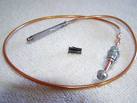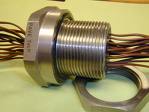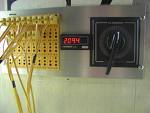Repair of thermoelectric converters
Inspection of thermoelectric converters
The thermocouple is disassembled into separate parts, cleaned of dirt and carefully examined to determine the condition of the thermoelectrodes and their working end, clamps on the head pad and the lining itself, a ceramic insulating shell (cup) for the working end of the thermocouple and a protective pipe.
When checking thermocouples, the thermoelectrodes of which are made of base metals or alloys (copper, copper, chromel, alumel, etc.), the absence of transverse cracks, which sometimes appear as a result of prolonged operation of the thermocouple at high temperatures for thermoelectrodes, is checked or as a result of frequent alternating temperature changes, the medium under investigation, then up, then down.
The appearance of cracks in the thermoelectrodes can also be a consequence of mechanical stresses from incorrect reinforcement of the thermocouple. Thus, the use of two-channel insulators with thick thermoelectrodes often leads to failure of the thermocouples.It is unacceptable for a thermocouple, especially one made of thick thermoelectrodes, to rest with its working end on the bottom of a protective tube or an insulating ceramic insert (cup).
When externally examining thermocouples, thermoelectrodes of which are made of precious metals or alloys (platinum, platinum-rhodium, and others), check the absence of "intersections" on their surface - small indentations, so to speak, from a knife blow. When detected, thermoelectrodes in places where "crossings" are visible are broken and welded.
Annealing of precious metal thermocouples
 Under operating conditions at very high temperatures, it is not always possible to protect platinum-rhodium and platinum thermoelectrodes from exposure to reducing gas media (hydrogen, carbon monoxide, hydrocarbons) and corrosive gas media (carbon dioxide) in the presence of vapors of iron, magnesium and silicon oxides. Silicon, present in almost all ceramic materials, poses the greatest threat to platinum-rhodium-platinum thermocouples.
Under operating conditions at very high temperatures, it is not always possible to protect platinum-rhodium and platinum thermoelectrodes from exposure to reducing gas media (hydrogen, carbon monoxide, hydrocarbons) and corrosive gas media (carbon dioxide) in the presence of vapors of iron, magnesium and silicon oxides. Silicon, present in almost all ceramic materials, poses the greatest threat to platinum-rhodium-platinum thermocouples.
The thermal electrodes of these thermal converters readily absorb it with the formation of platinum silicides. There is a change in the thermo-EMF, the mechanical strength of the thermoelectrodes decreases, sometimes they are completely destroyed due to the resulting fragility. The presence of carbonaceous materials such as graphite has an adverse effect because they contain impurities of silica, which at high temperatures in contact with coal are easily reduced with the release of silicon.
To remove contaminants from precious metal or alloy thermoelectrodes, the thermocouples are annealed (calcined) for 30 … 60 minutes with an electric current in air.For this purpose, the thermoelectrodes are released from the insulators and suspended on two stands, after which they are degreased using a swab moistened with pure ethyl alcohol (1 g of alcohol for each sensitive element). The free ends of thermoelectrodes are connected to an electrical network with a voltage of 220 or 127 V and a frequency of 50 Hz. The current required for annealing is regulated by a voltage regulator and monitored with an ammeter.
 Sensitive elements of thermocouples with a calibration characteristic PP (platinum rhodium - platinum) with thermoelectrodes with a diameter of 0.5 mm are annealed at a current of 10 — 10.5 A [temperature (1150 + 50) ° C], sensitive elements with a calibration characteristic of the type PR -30/6 [platinum rhodium (30%) — platinum rhodium (6%)] are annealed at a current of 11.5 … 12 A [temperature (1450 + 50) ° C].
Sensitive elements of thermocouples with a calibration characteristic PP (platinum rhodium - platinum) with thermoelectrodes with a diameter of 0.5 mm are annealed at a current of 10 — 10.5 A [temperature (1150 + 50) ° C], sensitive elements with a calibration characteristic of the type PR -30/6 [platinum rhodium (30%) — platinum rhodium (6%)] are annealed at a current of 11.5 … 12 A [temperature (1450 + 50) ° C].
During annealing, the thermoelectrodes are washed with brown. For this, borax is poured onto a tin or other plate and then the plate is moved along the heated thermoelectrode so that it is immersed in borax (do not forget about the electrical conductivity of the plate). It is enough to pass a plate with a drill over the thermoelectrode 3-4 times so that the platinum-rhodium and platinum are clean, without contamination of the surface.
Another method may be recommended: a drop of borax is melted on a hot thermoelectric electrode, allowing this drop to roll freely.
At the end of the annealing, the current was gradually reduced to zero within 60 s.
After cleaning, residual borax on the thermoelectrodes is removed: large drops — mechanically and weak residues — by washing in distilled water. The thermocouple is then annealed again.Sometimes brown washing and annealing is not enough because the thermoelectrodes still remain solid. This indicates that the platinum has absorbed silicon or other non-combustible elements and must be refined at the refinery where the thermoelectrodes are sent. The same is done if surface contamination remains on the thermoelectrodes.
Checking the homogeneity of the thermoelectrodes
 In the practical use of a thermal converter, a certain temperature difference is always detected along its length. thermoelectrodes. The working end of the thermocouple is usually located in the area of highest temperature, for example in the center of the chimney. If you move a certain temperature meter, for example, the working end of the thermal converter (connected to another millivoltmeter), along the thermal electrodes of the first thermal converter in the direction from the working end to the free ends, then the temperature decrease will be marked by the distance from the center of the chimney to its walls.
In the practical use of a thermal converter, a certain temperature difference is always detected along its length. thermoelectrodes. The working end of the thermocouple is usually located in the area of highest temperature, for example in the center of the chimney. If you move a certain temperature meter, for example, the working end of the thermal converter (connected to another millivoltmeter), along the thermal electrodes of the first thermal converter in the direction from the working end to the free ends, then the temperature decrease will be marked by the distance from the center of the chimney to its walls.
Each of the thermoelectrodes along the length usually has an unevenness (inhomogeneity) — a small difference in the composition of the alloy, work hardening, mechanical stresses, local contamination, etc.
As a result of the uneven temperature distribution on the thermoelectrodes and their inhomogeneity in the thermoelectric circuit, inherent thermo-EMFs arise, inherent in the points of inhomogeneity of the thermoelectrodes, some of which are added, some are subtracted, but all this leads to a distortion of the measurement result of the temperature.
To reduce the effect of inhomogeneity, each thermocouple thermocouple made of precious metals, especially exemplary, is checked for homogeneity after annealing.
For this purpose, an upright thermoelectric to be tested is introduced into a disconnected small tube electric furnace capable of creating a local heat field when heated. The negative terminal of the sensitive zero galvanometer is connected to the positive thermoelectrode, the positive terminal of the regulated voltage source (IRN) is connected to the positive terminal of this galvanometer, and the negative thermocouple thermocouple is connected to the negative terminal of the IRN. Such inclusion of the IRN makes it possible to compensate (balance) the thermo-EMF of the thermocouple with the voltage from the IRN. In order not to damage the sensitive zero galvanometer, a coarser zero galvanometer is first turned on, the thermo-EMF is compensated, then the zero galvanometers are reversed and the final thermo-EMF compensation is carried out using IRN rheostats for smooth adjustment of the sensitive zero galvanometer.
Turn on the electric furnace, create local heating of the tested thermoelectrode and slowly pull it through the furnace along its entire length. If the metal or alloy of the thermoelectrode is homogeneous, the pointer of the zero galvanometer will be at the zero mark. In case of inhomogeneity of the thermoelectrode wire, the pointer of the zero galvanometer will deviate to the left or right of the zero mark. The inhomogeneous part of the thermoelectrode is cut out, the ends are welded and the seam is checked for homogeneity.
In the presence of a minor inhomogeneity, where the additional thermo-EMF does not exceed half the permissible error for the thermo-EMF of a given pair, the thermoelectrode section shall not be cut and the said inhomogeneity shall be disregarded.
Preparation of thermoelectrodes for welding
If the length of the remaining unburnt thermoelectrodes allows, a new one is made instead of the destroyed working end.
If it is possible to make a thermocouple from new thermoelectrodes, the compatibility of the thermocouple material with the manufactured thermocouple is checked in the most careful way to ensure its quality.
For this purpose, on the basis of regulatory documents, the type of material, its technical characteristics and the results of material testing are determined by the quality control department (technical control department) of the manufacturer. If these data meet the technical requirements, the material can be used; otherwise it is tested.
To check for homogeneity, a piece of the thermoelectrode is cut from the coil of material longer than that required for the manufacture of the thermocouple, after which short copper connecting wires are connected to the ends of the thermoelectrode using clamps. The clamps were lowered into insulating containers with melting ice (0 °C) and the homogeneity of the thermoelectrode material was determined.
To determine the type of material and its grade, about 0.5 m of the thermoelectrode is cut from the coil and welded to the same piece of platinum wire.The working end of the resulting thermocouple is placed in a steam thermostat with a temperature of 100 ° C, and the free ends are taken to heat-insulating vessels with melting ice (0 ° C) and connected with copper wires with a potentiometer. The type and grade of the material is determined by the thermo-EMF developed by the thermocouple.
In appearance, chromel differs slightly from alumel, but chromel is harder than alumel, which is easily determined by bending, and in addition, alumel is magnetic, unlike non-magnetic chromel.
